Magnesium is a mineral found in every cell in the body. It has a role in keeping your body functioning optimally. Blah blah blah, am I right? Every article about magnesium says those same things, so I’ll leave you to read those articles to get a sense of how magnesium is used in the body. I recommend Wikipedia and not some health blog, of course.
Today, let’s try to get some useful information that the other articles won’t tell you. I believe that a majority of consumers of magnesium supplements are wasting their money on overpriced products that aren’t even moving the needle on their magnesium levels.
Let’s begin with a gentle statement of the current magnesium supplement market…
Magnesium Supplements Are Mostly Garbage
I’m coming out of the corner swinging this week folks.
Lesson number one: magnesium, being a mineral, doesn’t exist freely. This means that you can’t get a bowl, capsule, or snow cone of elemental magnesium – the little magnesium ions you may remember learning about in high school chemistry.
Magnesium will always be stuck or bound to another compound. This stabilizes it, but more importantly, it allows the natural products industry to put it into decorated plastic bottles and charge people $50.
The most common compounds magnesium are bound to are oxide or citrate molecules. When we talk about the different ways a mineral can be bound, we are talking about the different mineral salt forms. Most people buy magnesium supplements in the oxide or citrate salt form.
What a mineral is bound to will determine a couple things. First, it will determine the “dose” of the mineral. Some magnesium salts will have be able to hold lots of elemental magnesium. Some will not.
There’s confusion when it comes to understanding how much magnesium are you actually getting. It’s important to note that minerals can be labelled as the weight of the whole salt form or just the amount of the mineral itself.
To stop the confusion, always look for the elemental magnesium amount.
The table below shows the common magnesium salt forms, their total weight, and their elemental weight:

The magnesium glycinate label shows 400mg, but that’s not even PER CAPSULE. That’s for the serving size, meaning you need 3 capsules of Magnesium Glycinate 400mg to get the 400mg. There’s only 133mg per capsule. It’s all a bit much, don’t you think?
“You haven’t told us why they are garbage yet!” You’re right, voice in my head. You’re always so right.
The second thing a mineral salt form will determine is the absorption. No, not all mineral salt forms are equal. In fact, they are as far from equal as you can get.
Drum roll: the most commonly used forms of magnesium have the WORST absorption. I’m talking next to nothing. Here’s a simplified table with the approximate absorption added to it:

Many of us are buying magnesium supplements with the intention of raising the magnesium levels in our blood. Most forms of magnesium that we buy will have little to no actual absorption of magnesium. Gadzooks!
Therefore, most magnesium products on the market are, as my friends in the UK would say, absolute rubbish.
Most Magnesium Is For Pooping
Where else have we seen magnesium oxide and magnesium citrate besides in overpriced supplements?
Hmmm.. Oh yeah! Here:
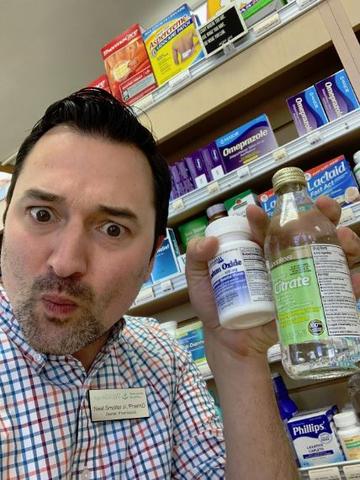
Both of the above products are on pharmacy shelves across the country, normally found in the GI section, right next to the other laxatives.
“Laxatives? What What What?!” Yeah, I know.
When you take a big dose of magnesium that is barely absorbed, where does it go? It doesn’t disappear, of course! It follows the tube out, and the only way out is down!
Magnesium is an osmotic laxative. When large amounts of magnesium are present in the GI tract, it causes water to flow out from inside our body out into the GI tract. This isn’t good news for your underwear if you aren’t prepared for it.
Not only are you not absorbing that magnesium supplement you are taking for migraine or bone support, but now it’s staying in your gut and causing a potential loose bowel episode.
What’s worse is that using magnesium oxide or citrate supplements over the long term can cause electrolyte shifts. It’s slightly complicated, but basically osmotic laxatives like magnesium can make your body lose more electrolytes (magnesium, potassium, calcium, etc) easier, leading to further problems.
If you are taking magnesium oxide or magnesium citrate, you are taking a product that is better suited for it’s GI effects as a laxative than it is for it’s effects in the blood.
Magnesium oxide is a very “natural” form of magnesium, so many practitioners will promote it over “synthetic” forms. Despite the fact we’ve blown this misconception out of the water previously, I’ll do it again briefly. There’s a difference between chemically modified (what people believe synthetic means – it doesn’t) and naturally occuring.
Here’s a sneak peak at a future rant: natural “practitioners” will often recommend magnesium oxide or citrate supplements, overpriced and dressed up as premium quality, to help people who are a bit constipated.
If being used for the gut, that’s not a major problem. Because guess what, it works! But, it’s a poor choice because of these electrolyte problems. In fact, most bowel protocols (the fancy term for the algorithm REAL medical professionals use to help induce bowel movements safest) will not recommend magnesium oxide or citrate until most other options are exhausted.
Mag oxide is the 4th string quarterback. It’s a $4 supplement priced at $30+. They’re ripping people off and giving bad advice, but “oh it’s natural, so it’s better than the other stuff!” or however they talk. In this case, these natural options are the WRONG choice.
That sounds like a fun thing to rant about, no?
Full transparency: I have one of those too! I don’t recommend it, but if people are adamant they want it, I’ve got a clean one for them!
Don’t Overpay For Your McDonald’s Cheeseburger
Here’s a riddle for you, if my comedy learning isn’t enough: What’s the difference between these two magnesium oxide products?
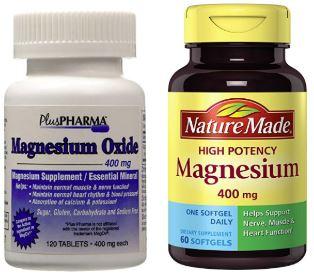
The one on the right is 20 cents per 400mg dose. The one on the left is 2.5 cents per 400mg dose.
In our piece, The 3 Types Of Dietary Supplements, we say that when you go to buy a supplement (a steak), you really are buying a moldy cheeseburger, a McDonald’s cheeseburger, or maybe you luck out and actually get the steak you seek.
Magnesium oxide or citrate supplements, for the most part, aren’t those dangerous moldy cheeseburgers, but are just the fast food “meh” burgers. Not directly bad for you today, but over a long time, probably aren’t a great idea.
The argument that they’re not REALLY helping hasn’t REALLY changed anyone’s minds on using supplements. But people normally listen to their wallets!
No one should pay more than $1 for a McD’s cheeseburger. Unless a cheeseburger price has gone up. I try not to eat there. The point is, a “meh”-burger has no true added value, so we should be paying the minimal possible for it.
Many are buying mega-bucks versions of these magnesium supplements. I saw one just today from a mega-long time customer, from a mega-vitamin company with a synonym for large and the word “food” in their name.
This “Mega”-“food” sourced magnesium was nothing more than a yeast-fed magnesium oxide. They neglected to include the “oxide” part, knowing consumers may be turned off but also knowing they won’t look deep into it. This product costs $24 right now on Amazon. The same product costs about $4 from any pharmacy across the country.
Don’t spend more than $4 on magnesium oxide. But also, don’t buy magnesium oxide. Unless you’re constipated.
Chelated Magnesium For The Win
In general, I only recommend chelated mineral supplements. Chelated means stuck to a larger molecule in a slightly different way, chemically, than the oxide or citrate salt forms.
An example of chelated magnesium is magnesium glycinate or Easy Magnesium, which is a special branded chelate called TRAACS. Here’s what a real chelate looks like:
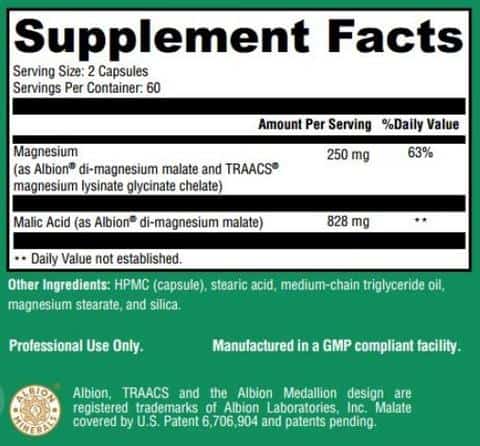
Buyer beware: there are bootleg magnesium chelates. Of course some manufacturers know that people are looking for magnesium chelates. How can we make people think they’re getting a chelate, when in fact they are not? Proprietary blends!
Check this literal bad boy out:
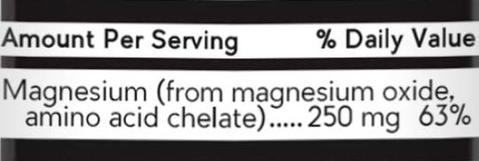
This product LOOKS like it’s a chelate, but it’s a blend with other non absorbable forms of magnesium. A majority of the elemental magnesium you get from these fake chelates has poor absorption. This is not a rogue product, this is the norm.
The front of the bottle is labeled Chelated Magnesium! It was literally the first example when I googled “chelated magnesium.”
Now you know a dirty little trick these natural products industry liars pull. I think that’s pretty valuable info, don’t you?
The absorption of chelates will be higher, as we illustrated in those earlier tables, but they are not perfect. Even a chelate will have only 40-50% absorption, meaning some amount will make its way to the colon and have an osmotic laxative effect.
I know lots of people who use chelated magnesium and DON’T experience this unwanted side effect. Why? It’s a dose related thing. Magnesium oxide 400mg delivers 240mg and about 230mg of that stays in the gut. Easy Magnesium will deliver 125mg and about half will get absorbed, meaning about 60mg stays in the gut.
If you go a little crazy with even the best chelates, you’ll be upping your magnesium levels in the gut and are more likely to have the abdominal side effects. So, it’s best to cap magnesium intake from chelates to 300mg-ish.
“But My Doctor Said To Take 400mg Of Magnesium.”
I want to bash on the docs a little bit, but then shed some light on their decision.
A patient is recommended to take magnesium supplements by their doctor for whatever reason. The doctor says, “Go to any store and get magnesium 400mg.” The customer comes in, I proceed to run down everything I’ve covered thus far, but with far fewer words. It is possible, don’t be a wise guy or gal.
The patient doesn’t want to hear what I’m saying as I’m technically “going against” what the doc is saying, and picks up the 400mg magnesium that’s delivering only 240mg of magnesium but then only 4% at best is actually absorbed and now you have the runs.
Here’s a few notes on this interaction. First, the doctor probably doesn’t know the absorption is so poor, but I believe they should. Second, the doctor just wants you to get a product. It’s easier to find magnesium oxide than it is a non-bootleg chelate. I believe it’s better to do nothing than take mag oxide in this situation, but the doctor wants the person to get whatever they can.
This highlights that no one is having the real conversation. There’s a difference between the ingredients we recommend (magnesium) and the products we buy (magnesium oxide). If your doc recommends taking “400mg of magnesium,” they’re not telling you to get 400mg of elemental magnesium in a supplement. They mean, “the most common magnesium oxide is 400mg OF TOTAL SALT per dose.” Taking 400mg of elemental magnesium is a ton.
Don’t forget the second part of the magnesium discussion. They’re telling you that you need some supplementation. It’s best if you actually, you know, absorb the stuff. So if they’re telling you to look for 400mg of magnesium oxide, you’ll be getting 240mg of elemental magnesium but that form is garbage. Find a chelate that yields 240mg of elemental magnesium and have the added benefit of actually absorbing the stuff! This makes your wallet, your doc, and your Holistic Pharmacist happy.
Magnesium Food Sources
I have a Food First mentality. Eat your micronutrients from a varied diet. It is quite easy to meet or exceed your dietary requirements of magnesium just by eating some yummy foods. Here’s a short list with an approximate yield per serving:
- Almonds, Cashews, and Other Nuts & Nut Butter – 80 mg
- Spinach – 80 mg
- Avocado – 40 mg
- Dark Chocolate – 60 mg
- Brown Rice – 40 mg
- Pumpkin Seeds – 30-45 mg
- Beans 30-60 mg
My favorite magnesium source: dark chocolate covered peanuts with a thin candy shell. THAT’s why I eat a pillow-sized bag at a time – magnesium deficiency!
How Much Magnesium Do We Need?
Most of us do not need to worry about getting enough magnesium. If we’re eating a healthy, varied diet, we’re getting plenty of magnesium-rich foods along with not-so-rich foods, so we’ll easily exceed recommended amounts.
Europe and the US both agree on an ideal range of magnesium for adults: 300-400ish mg a day.
Here’s the info straight from the horse’s mouth, the horse being the NIH and its mouth being this chart:
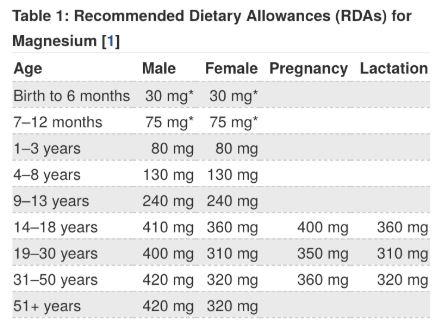
Deficiency is rare, because our kidneys are programmed to only get rid of magnesium if in excess, but hold onto it if the numbers fall. The most common reasons people might not have enough magnesium in their blood is if they have diarrhea, alcoholism, or inflammatory bowel diseases like Crohn’s.
The bad news for our more senior crowd: we’re quicker to excrete magnesium and less likely to absorb magnesium over the age of 60. Just make sure you do your best to eat your spinach, especially at 60+.
As we spoke in our Reflux Redux article, one of the complaints about the proton pump inhibitors (PPIs) is that we now know they can alter magnesium absorption, so supplementation is often necessary. No big deal – as long as you choose the right supplement, with our help of course!
The Calcium-Magnesium Conundrum
Bone health supplements is one of those categories that is just a webbed mess of misinformation. I’ve attacked the misconceptions pretty consistently over the years, but most recently on our Bone Health podcast episode and in our Calcium Doesn’t Work article. Let’s lay the magnesium-bone confusion to rest.
“Supplementing With Magnesium Helps Bones”
This is a big maybe. We know conclusively that low magnesium will lead to weak bones. But much like our discussion around Vitamin K, taking extra magnesium probably won’t make your bones any stronger. There are a few bits of studies that show taking extra magnesium can move the needle, so it definitely won’t hurt you.
“Magnesium Is More Important Than Calcium For Bones”
Definitely not. Magnesium is a part of the whole picture, but calcium is the major nutritional component that makes our bones stronger.
You must start young – anytime before 30 – to start ingesting enough dietary calcium AND magnesium to ensure your bones are as dense as they can be before the swirly-twirly slide of middle and advanced age drags us down into brittle bone land.
“You Need a 2:1, 3:1, 4:1, Whatever:1 Ratio of Calcium To Magnesium”
This is interesting. I had my pharmacy intern do a data scrub for me. We couldn’t come up with anything of any substance in any journal that talks about any specific, more effective ratio of calcium to magnesium intake on bones.
If you look at the recommendations from national and global health organizations, you’ll see most post-menopausal women need 1200mg of calcium and about 300mg of magnesium. For men it’s 1000mg and 400mg. So the real ratio for good health is 4:1 in women and 2.5:1 in men.
We dug a bit into the 2:1 ratio thing, as that’s the one that is so persistent. Heck, that’s what I used to say myself! This was before I grew to be the Big Mouth Pharmacist I am today, so don’t hold it against me. Anyway, we found that all of this “knowledge” stemmed from a single naturopath. She literally made it up. She just started writing about it, how it’s so important, yadda yadda. She’s patient zero in the 2:1 magnesium epidemic!
Everything You Didn’t Think You Needed To Know About Magnesium
I hope I touched on enough to really give you insight to proper magnesium supplementation.
The scope of the article is to cover the majority of people. Most of us look to magnesium supplements to increase magnesium in the blood, so it’s best to get a form that actually gets absorbed: chelated magnesium.
There are others who need magnesium oxide or citrate, either for the GI/laxative effects or for some other reason. People with frequent kidney stones can technically use magnesium citrate to help clear stones.
The goal for us is to consume enough magnesium from dietary sources. If additional magnesium is needed, supplement with the proper forms and correct doses.
Remember, though, the biggest problem here is the misinformation and misconceptions around magnesium supplementation.
Just trying to keep it real…

Neal Smoller, PharmD
Owner, Pharmacist, Big Mouth



